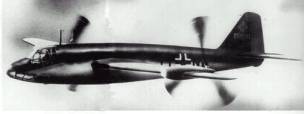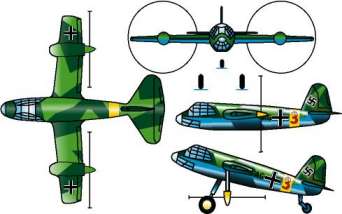
""
FOCKE-ACHGELIS
|
FOCKE-ACHGELIS |


|
|
|
El Focke Achgelis 269 "convertiplane" fue diseñado en 1943, despues de que se consideraba tener bastante experiencia en el campo de los helicópteros. El propósito del "convertiplane" era combinar el aterrizaje y despegue vertical con la velocidad de un avión. El Fa 269 tenía una configuración de ala media con un motor (Daimler Benz 601 ó 605) en cada una de ellas, con unas hélices bastante grandes. Este proyecto fue abandonado en 1944 debido al considerable desarrollo que debían realizar para construir las cajas de transmisión, el mecanismo de pivoteo, etc. No se construyó ningún prototipo. |
|
|
|
There was a special pivoting gearbox at the front of each engine, from which a drive shaft passed back between the engine cylinder banks to drive its propeller behind the wing trailing edge. In the completely down position, the propellers were almost parallel to the ground. A very long tailwheel undercarriage was thus necessitated, which retracted into the fuselage. A crew of two sat in a stepped cockpit located in the extreme nose, with the underside being extensively glazed also. This project was abandoned in 1944 due to the considerable development that would have been needed for the special gearboxes, drives, pivoting mechanisms and the propeller pitch control systems for use in landings and takeoffs. German Aircraft of the Second World War, by Smith & Kay |
|
|
|
Characteristics |
Information |
Characteristics |
Information |
| First
Flight Primer Vuelo |
1943 Project | Engine Motor |
2 Daimler-Benz DB 601 |
| Seating
Capacity Plazas |
1 / ? |
Power Potencia |
HP |
| Empty
Weight Peso Vacío |
Lb |
Hover
Ceiling O.G.E. Estacionario O.G.E |
Ft |
| Maximum
Weight Peso Máximo |
4410 Lb |
Hover
Ceiling I.G.E. Estacionario I.G.E |
Ft |
| Vel.
Cruise Vel. crucero |
Kts |
Service
Ceiling Techo de Servicio |
Ft |
| V.N.E. V.N.E |
375 Kts |
Maximum
Range (Std) Alcance (Std) |
NM |
|
Dimensions / Dimensiones |
|||
| Total
Length Largo Total |
32,8 Ft |
Main
Rotor Diameter Diam. Rotor Principal |
NA |
| Total
Height Alto Total |
29,19 Ft |
Tail
Rotor Diameter Diam. Rotor de Cola |
NA |
Copyright © 1999 / 2003